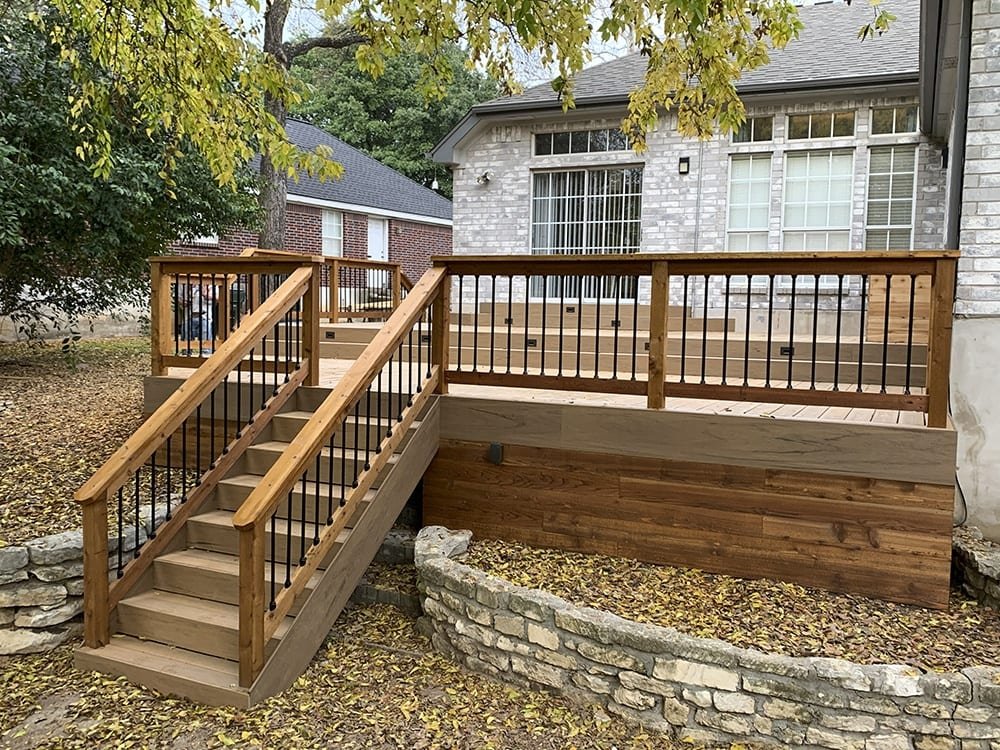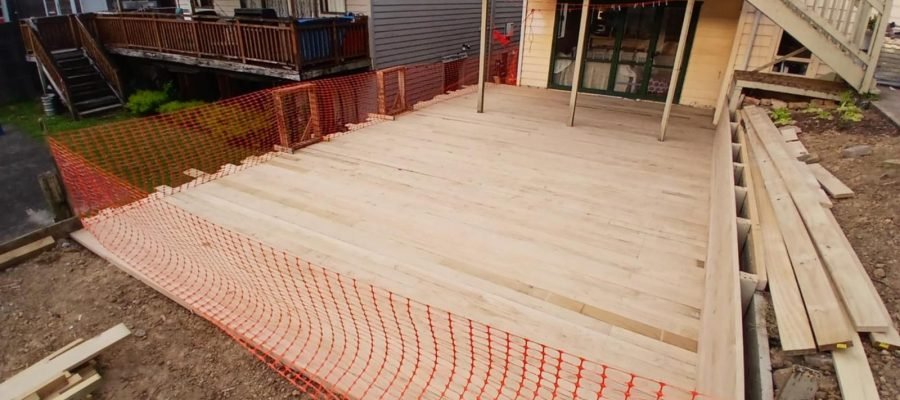How to Clean Decking Naturally: Eco-Friendly…
Discover how to clean decking naturally in Auckland. Use DIY solutions like vinegar & baking…

Building decking on a slope can transform an underused, tricky backyard into a stunning outdoor space, perfect for entertaining or relaxing. For Auckland homeowners, where hilly terrain is common, a sloped deck offers both a challenge and a rewarding opportunity. Not only does it maximise usable space, but it also adds aesthetic appeal and can increase property value. However, constructing a deck on uneven ground requires careful planning, the right materials, and a focus on safety and structural integrity. While many DIY enthusiasts can tackle this project, steep slopes or complex designs often benefit from professional expertise. In this guide, we’ll walk you through the process of building decking on a slope, tailored for Auckland’s unique climate and terrain. For those needing expert help, My Homes Decking Expert is Auckland’s trusted choice for durable, beautiful sloped decks.
Sloped backyards are common in Auckland, especially in suburbs like Titirangi or the North Shore, where hilly landscapes dominate. While these slopes can seem daunting, a well-built deck offers numerous benefits:
However, building on a slope comes with challenges like ensuring stability, managing drainage, and complying with NZ building codes. While DIYers can handle smaller projects, steep or unstable terrain often requires professional input to ensure safety and longevity.
Before picking up a hammer, you need to assess your slope and plan a deck design that suits your backyard. Proper planning ensures structural integrity and compliance with local regulations.
Start by determining the slope’s steepness, as this will influence your deck design and construction approach.
Your slope’s gradient will determine the best deck design:
Consider your backyard’s usage—do you want a large entertaining area or smaller zones for dining and lounging? Multi-level decks offer flexibility but are more complex to build.
In Auckland, deck construction must comply with the New Zealand Building Code (NZBC) and local council rules:
Contact Auckland Council or check their website to confirm requirements. For complex projects, My Homes Decking Expert can handle permitting and compliance, ensuring your deck meets all regulations.
Building a sloped deck requires specific tools and materials to ensure durability and safety in Auckland’s wet, coastal climate. Here’s what you’ll need:
Tip: Use timber treated to H3.2 or H4 standards, as these are designed for outdoor exposure in NZ’s wet climate. Avoid untreated timber, as it will rot quickly in Auckland’s conditions.

Follow these steps to build a sturdy, safe deck on a slope. This guide assumes a moderate slope (10–15% gradient) and a platform-style deck, but you can adapt for multi-level designs.
Prepare the site to ensure a stable base for your deck.
Safety Callout: Wear gloves and sturdy boots to avoid injury while clearing the site, especially on uneven ground.
Footings provide a stable foundation, critical for a sloped deck.
Proper footing depth ensures your deck can handle the uneven load distribution of a sloped site.
Support posts create the foundation for your deck frame.
Tip: Use a spirit level to double-check each post’s alignment as the concrete sets. Misaligned posts can compromise the entire deck.
The frame supports your decking boards and ensures stability.
Cross bracing is essential on slopes to handle the uneven weight distribution and prevent wobbling.
Now it’s time to lay the decking boards for a polished finish.
Proper spacing and alignment ensure water drains off the deck, preventing rot and extending its lifespan.
Steps and railings make your deck safe and accessible.
Safety Callout: Double-check railing stability—loose railings are a safety hazard, especially for kids or elderly users.
These expert tips will ensure your sloped deck withstands Auckland’s climate and heavy use:
Visual Suggestion: Include a diagram showing post placement, cross bracing, and drainage gravel under the deck for clarity.
While DIY decking is rewarding, some situations require professional expertise:
My Homes Decking Expert specializes in sloped decking projects across Auckland, ensuring your deck is safe, compliant, and built to last.
Transform your sloped backyard into a stunning outdoor space with My Homes Decking Expert. We specialize in designing and building durable, beautiful decks tailored to Auckland’s unique terrain and climate. Whether you’re tackling a steep slope or a multi-level design, our team ensures safety, compliance, and a flawless finish.
👉 Trust My Homes Decking Expert to make your dream deck a reality.
📞 Call us at: 022 315 8987
📧 Email: info@myhomesconstruct.co.nz
🌐 Visit: deckingexpert.co.nz
Let the pros handle the hard work—contact us today for a free consultation!
Q: Can I build a deck on a steep slope myself?
Yes, for moderate slopes (under 15%), if you have DIY experience and follow safety guidelines. Steeper slopes (over 20%) often require professional engineering for stability.
Q: Do I need council approval for a sloped deck in Auckland?
If your deck is over 1.5 metres high, you’ll need a building consent from Auckland Council. Decks over 1 metre also require railings per NZBC Clause F4.
Q: What’s the best timber for decks in New Zealand’s climate?
Treated pine (H3.2 or H4), kwila, or vitex are excellent choices. They resist rot and withstand Auckland’s wet, salty conditions. Composite decking is a low-maintenance alternative.
Q: How do I prevent erosion under the deck?
Use gravel or a drainage layer under the deck to manage runoff. Consider a retaining wall for steep slopes, and plant ground cover to stabilize soil.
Q: How long does it take to build a sloped deck?
For a DIYer, a small platform deck may take 2–3 weekends. Larger or multi-level decks can take longer, especially if you need council approvals.
Q: Can I use untreated timber for my deck?
No, untreated timber will rot quickly in Auckland’s climate. Always use treated timber (H3.2 or higher) or hardwoods designed for outdoor use.
Q: How do I ensure my deck is level on a slope?
Use a laser level to set post heights, ensuring the frame is level despite the slope. Adjust post lengths and check alignment at every step.
Q: What’s the cost of hiring a professional for a sloped deck?
Costs vary, but a professional sloped deck in Auckland may range from $5,000–$15,000, depending on size and complexity. Contact My Homes Decking Expert for a quote.
Building decking on a slope is a fantastic way to unlock the potential of your Auckland backyard, creating a functional and beautiful outdoor space. By carefully assessing your slope, planning your design, and following these step-by-step instructions, you can construct a sturdy, safe deck that enhances your home. Prioritize safety, use quality materials, and ensure compliance with NZ building codes to achieve a lasting result. For steep slopes, complex designs, or time constraints, professional help can save you stress and ensure a flawless finish.
My Homes Decking Expert is here to bring your vision to life with custom sloped decking solutions in Auckland. Call us at 022 315 8987, email info@myhomesconstruct.co.nz, or visit deckingexpert.co.nz to get started. Let’s build a deck you’ll love for years to come!
Discover how to clean decking naturally in Auckland. Use DIY solutions like vinegar & baking…
Kwila Decking for Auckland Homeowners How Long Does Kwila Decking Last? A Comprehensive Guide for…
How to Build a Deck: A Comprehensive Step-by-Step Guide Introduction Did you know that adding…